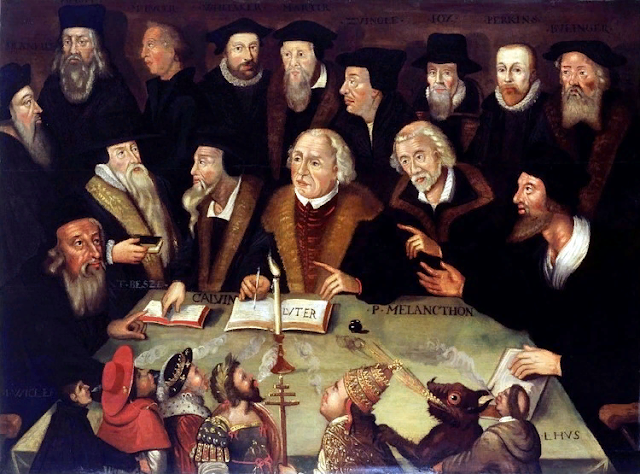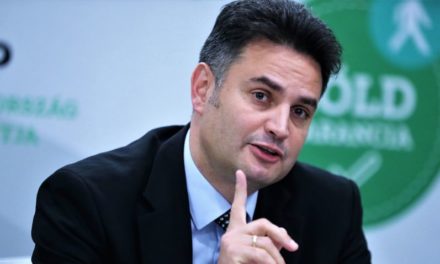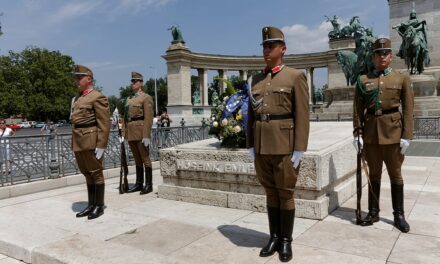In earlier times, during the month of the Reformation, the churches held weeks and days of repentance. This practice, which is so fitting to the essence of the reformation and which grew out of it, has certainly waned by now, it has been relegated to a few days at most.
Of course, you can refer to sociological and church sociological facts (little free time, little participation, interest), but this does not change the essence.
What's the point?
What the Reformation painting in the Lutheran Church in Copenhagen and the work of Lucas Cranach express: the Reformation is the renewal of the community with God, through Jesus Christ, following the work of the Holy Spirit.
The revival and renewal of that community, which in both paintings clearly expresses the fact that the Reformation is a common cause, since in the large group picture, German, Swiss, Scottish, and English reformers form a congregation, a church. The candlelight in the middle of the painting symbolizes the clear heavenly message, the gospel, and its living source, the resurrected Lord Jesus Christ.
Following this, Kálvin wrote, among the first to use the word reformation more and more often in his letters, that the church needed to be purified, the faith to be purified.
This month, we look back at the heavenly gift that cannot be explained in a few days or a single festive occasion, at the huge spiritual-spiritual-material-moral light flood of the 16th century and beyond, at the renewal of faith. Giving the Protestant roots of Europe and the whole world, our reformers, the respect they deserve and deserve, did not stop, but instead gave them the respect they deserve.
And to God be the glory! After all, there would have been no renewal without Him. As a Czech reformer later wrote: The reformation will either be a complete purification and renewal of the heart and life or it will have no meaning.
So let us pay attention to our early believers, as the art culture of the Reformation so richly proclaims the bright deeds of their purified faith, as our most precious living heritage, with the written underlining of Calvin's letters.
Reformation - The use of words in the Calvinist letters about masked Christianity
For nearly forty years, every October, by the grace of God, I have taken out the almost 1,000-page, two-volume, Gothic script, published in Tübingen in 1909, a great collection volume that presents Kálvin's oeuvre based on his letters. The word reformation occurs abundantly in this. It's worth recalling!
Already in 1548, a letter written to one of the pastors in the city of Lausanne shows the urge for church solidarity and unity, so that they do not hide themselves in slavish silence against clerical and secular power tyrants, but speak openly about the gospel of truth.
Even this year, in his fantastically clear mini-essay written to the Duke of Sommerset, Eduard Seymour, on 9 and a half pages, he details the true method of reformation, with which the Duke can zealously continue the reformation begun in England.
Perceptible unrest due to the change of religion, i.e. conversion to the Protestant faith, must be borne with patience and the church must be reformed according to God's laws. In the meantime, you have to pay close attention to the Holy Spirit, who brings the desire for true religion to its goal. In the process, people can learn to look higher than the world around them. God's arms are not so short that he cannot reach those who look forward with true faith and desire.
Let us not look to ungrateful humanity, but to the faith and gratitude of God's biblical elect. The basis of true worship, Kálvin argues, is a heart purified by the Holy Spirit.
In order to lead the people on the religiously correct path and keep them on it, for spiritual progress, children and the spiritually uneducated need a catechism. "Monseigneur, no one can keep the Church of God without Káté," he wrote to the prince, urging him to publish it.
The Káté must state the essence of true Christianity in simple terms. Calvin himself gave an example of this with the Geneva Kate, then the Palatinate reformed fathers with the Heidelberg Kate, and the Swiss reformers in II. Helvetic Confession.
For centuries, these had a double benefit, as the Genevan reformer wrote in advance in his letter: it teaches the whole people the truth of the Gospel, and it teaches children from an early age to distinguish between true and false religiosity and faith.
The Káté is like a compass: it directs the heart from the inside to the correct church practice, i.e. to the clean administration of the sacraments, to the practice of individual and communal prayers, to a happy and then saved life. Without it, "the begun reformation" will stall.
In the letter to the duke, Kálvin describes the word reformation for the second time. If we want a reformation that is pleasing to God, then we must convert to God's commandments leading to a true and proper life, he says. Neither God nor we need a masked Christianity, which outwardly shows something different than what is inside, in the heart or in the church's internal relations.
With the word reformation used for the third time in the letter, he was referring to the basic truth, that "the reformation of His church is the work of His own hands", nothing other than human hands can lead to salvation. Kálvin uses the word reformation clearly and unambiguously for the fourth time in this mini-essay: "The reformation must only be divine, i.e. divinely led, no one can limit it to human interpretations. No one can subordinate the heavens to the earthly and the worldly."
The moral consequences of the correctly understood reformation can be interpreted very extensively. It is not only theft, murder, and robbery that must be condemned, which cause serious damage and injuries to people. Prostitution, adultery, alcoholism and the daily blasphemy of God's name must be curbed, even in such a varied form of blasphemy.
The very clear and clear logic of Calvin's letter already clarified the concept of the Reformation on October 22, 1548, when he wrote it. It did not mean a return to some biblical church form, since Jesus Christ did not found a church, but above all, the reformer used it to denote the purification, conversion, and turning of the heart to God.
It also indicated church purification and renewal - individual and community life reformation! He drew a picture of the church that targeted the degraded human conditions and was oriented towards the future. Above all, with the way that every single national reformer of the Reformation painting clearly and uniformly confessed the whole truth: ecclesia semper reformari debet! – the church must always be renewed!
Penicunia or pneuma - Money or soul?
The well-understood meaning and significance of the Reformation cannot be left in the lofty but often contradictory past. This still has a Sitz im Leben, a place in our lives.
What was the first thing that upset Luther and the others in the group photo and made them protest? Let's not avoid hot porridge: the business approach of the papal church of the time. The fact that the forgiveness of sins was not a spiritual event, but was degraded to the level of pecunia, money.
Salvation became a matter of give and take. Already at that time, the public perception of "the whole world is for sale" was a wreck and destructive to people.
The reformers protested against the pardons not only with mockery and public sermons, but in the great reformation centers: Wittenberg, Strassbourg, Heidelberg, Geneva, then in the Netherlands and England, including Scotland, then the New World, America, they excluded the spiritual with strict public laws. this vile practice of corruption.
They freed most of the world of the time from the spiritual tax collectors and the credulity-based practice of tax collection. They knew and stated that the church can only break out of this Babylonian captivity with conversion, internal and external renewal, pure teaching, the Bible and a morally demanding culture of life. And they did that.
That is why the Reformation became the driving force for the renewal of Europe, in which, according to the world economic analyzes of the Scottish 20th century macro-economist, Angus Magnusson, the countries and peoples of the Reformation in the 16th-20th centuries. during the 20th century, they exceeded the European Catholic countries several times in terms of per capita income and industrial performance.
Because the economic, cultural, social, diaconal and ecclesiastical fruits of the renewed faith have also been produced. According to his belief and practice of ora et labora, pray and work, in which Pneuma, the Spirit, is the priority over pecunia, money. Of the freedom and dignity of faith, against the postmodern constraints of the golden cage, against all forms of digital and financial slavery.
Dr. Lajos Békefy













